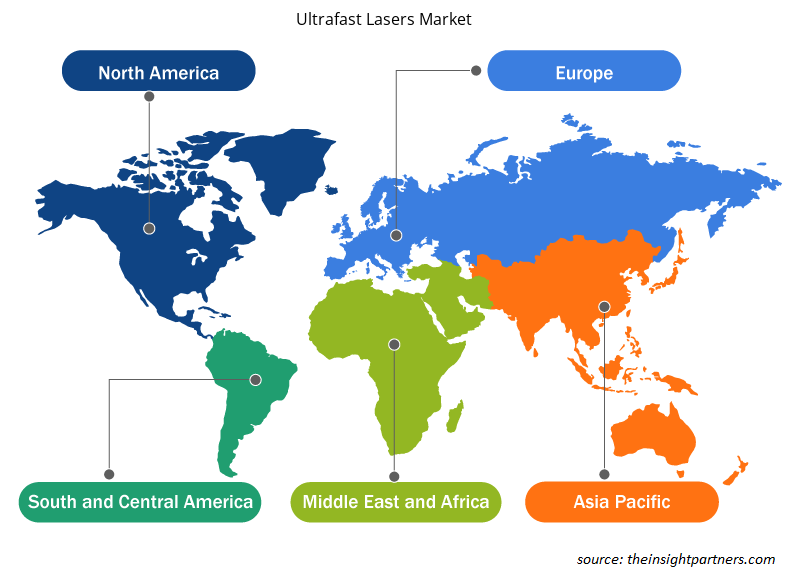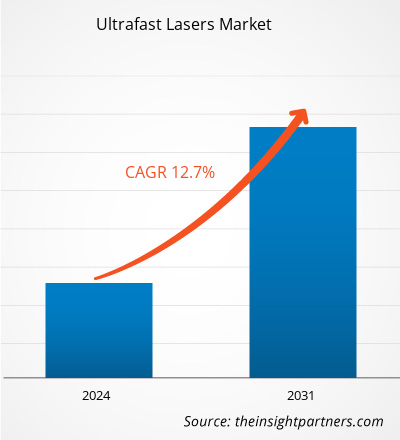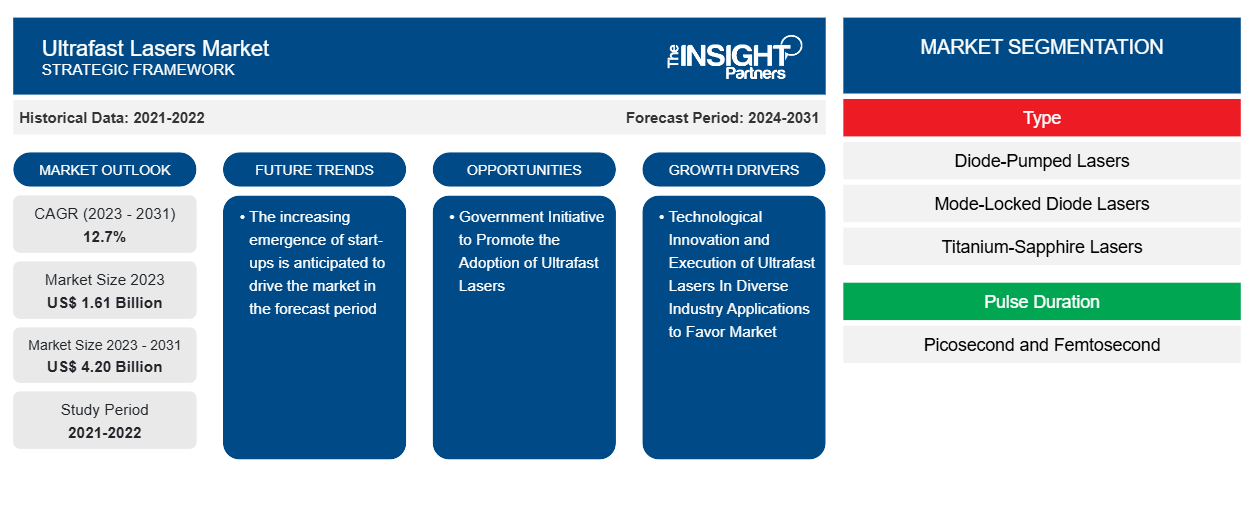Der Markt für Ultrakurzpulslaser soll von 1,61 Milliarden US-Dollar im Jahr 2023 auf 4,20 Milliarden US-Dollar im Jahr 2031 anwachsen. Der Markt soll zwischen 2023 und 2031 eine durchschnittliche jährliche Wachstumsrate von 12,7 % verzeichnen. Zunehmende technologische Innovationen und der Einsatz von Ultrakurzpulslasern in verschiedenen Industrieanwendungen dürften weiterhin wichtige Trends und Treiber des Marktes bleiben.
Ultraschnelle Laser Marktanalyse
Der Markt für Ultrakurzpulslaser verzeichnet weltweit ein starkes Wachstum. Das Wachstum ist auf Faktoren wie zunehmende technologische Innovationen und den Einsatz von Ultrakurzpulslasern in verschiedenen Industrieanwendungen zurückzuführen. Darüber hinaus wird erwartet, dass die zunehmenden Anwendungen der Lasertechnologie und die zunehmende Entstehung von Start-ups dem Markt zahlreiche Chancen bieten.
Marktübersicht für Ultrakurzpulslaser
Ultrakurzpulslaser erzeugen sehr kurze Lichtimpulse, die üblicherweise im Bereich von Femtosekunden oder Pikosekunden liegen. Ultrakurzpulslaser basieren auf Techniken wie der Modenkopplung zur Bildung einer Impulsfolge und sind dank der neuen Fortschritte in der Photonik in jüngster Zeit erfolgreich geworden . Solche Entwicklungen in der Lasertechnologie haben die Erzeugung von Impulsen mit einer Dauer von einigen Femtosekunden bis zu einigen zehn Attosekunden ermöglicht.
Passen Sie diesen Bericht Ihren Anforderungen an
Sie erhalten kostenlose Anpassungen an jedem Bericht, einschließlich Teilen dieses Berichts oder einer Analyse auf Länderebene, eines Excel-Datenpakets sowie tolle Angebote und Rabatte für Start-ups und Universitäten.
-
Holen Sie sich die wichtigsten Markttrends aus diesem Bericht.Dieses KOSTENLOSE Beispiel umfasst eine Datenanalyse von Markttrends bis hin zu Schätzungen und Prognosen.
Treiber und Chancen des Marktes für Ultrakurzpulslaser
Technologische Innovation und Einsatz von Ultrakurzpulslasern in verschiedenen Industrieanwendungen zur Förderung des Marktes.
Technologische Innovationen und der Einsatz von Ultrakurzpulslasern in verschiedenen Industrieanwendungen treiben das Marktwachstum tatsächlich voran. Ultrakurzpulslaser werden in Branchen wie Unterhaltungselektronik, Industrie, Automobilbau sowie Medizin und Wissenschaft und anderen eingesetzt. Ultrakurzpulslaser können für die Anforderungen der Automobilindustrie nützlich sein. Dazu gehört das Strukturieren kleiner Rillen in die Oberfläche der Zylinderwand eines Verbrennungsmotors. Dies gewährleistet eine gründliche Verteilung des Schmiermittels entlang der Kolbenwand, um Reibungsverluste zu minimieren. Es bietet auch einen Überblick über die modernen Fortschritte bei ultrakurzpulslaserbasierten Herstellungsprozessen, einige der interessantesten Industrieanwendungen und eine Diskussion über zukünftige Trends und Herausforderungen. Unter Berücksichtigung der oben genannten Parameter treiben die zunehmende technologische Innovation und der Einsatz von Ultrakurzpulslasern in verschiedenen Industrieanwendungen das Wachstum des Ultrakurzpulslasermarktes voran.
Regierungsinitiative zur Förderung der Einführung ultraschneller Laser.
Die steigende Zahl staatlicher Initiativen zur Förderung der Einführung ultraschneller Laser dürfte dem Markt für ultraschnelle Laser zahlreiche Chancen bieten. Die Ausbildung einer hochqualifizierten nächsten Generation von Talenten ist in mehreren Bereichen ein entscheidendes Thema, und die Forschung bildet hier keine Ausnahme. Aufbauend auf seiner Erfahrung in der wissenschaftlichen und akademischen Gemeinschaft startete NSERC im April 2023 ein ehrgeiziges Projekt zur Schaffung eines nachhaltigen Lernökosystems im Bereich der Wissenschaft und Technologie ultraschneller Laser. NSERC bot 1,65 Millionen US-Dollar für die nächste Generation von Talenten im Bereich der Wissenschaft und Technologie ultraschneller Laser.
Segmentierungsanalyse des Marktberichts für ultraschnelle Laser
Wichtige Segmente, die zur Ableitung der Marktanalyse für ultraschnelle Laser beigetragen haben, sind Typ, Pulsdauer und Anwendung.
- Der Markt für ultraschnelle Laser ist nach Typ in diodengepumpte Laser, modengekoppelte Diodenlaser, Titan-Saphir-Laser und Faserlaser unterteilt . Das Segment der diodengepumpten Laser dürfte im Prognosezeitraum einen erheblichen Marktanteil halten.
- Basierend auf der Pulsdauer wird der Markt für ultraschnelle Laser in Pikosekunden und Femtosekunden unterteilt. Das Pikosekundensegment wird im Prognosezeitraum voraussichtlich einen erheblichen Marktanteil halten.
- Nach Anwendungen ist der Markt in Unterhaltungselektronik, Industrie, Automobil sowie Medizin und Wissenschaft unterteilt. Das Segment Unterhaltungselektronik dürfte im Prognosezeitraum einen erheblichen Marktanteil halten.
Marktanteilsanalyse für Ultrakurzpulslaser nach geografischer Lage
Der geografische Umfang des Marktberichts für ultraschnelle Laser ist hauptsächlich in fünf Regionen unterteilt: Nordamerika, Asien-Pazifik, Europa, Naher Osten und Afrika sowie Süd- und Mittelamerika.
Nordamerika dominiert den Markt für ultraschnelle Laser. Die Einführung von Hochtechnologie in verschiedenen Branchen in Nordamerika hat das Wachstum des Marktes für ultraschnelle Laser vorangetrieben. Faktoren wie die zunehmende Einführung digitaler Tools und hohe Technologieausgaben von Regierungsbehörden dürften das Wachstum des nordamerikanischen Marktes für ultraschnelle Laser vorantreiben. Darüber hinaus zwingt eine starke Betonung von Forschung und Entwicklung in den entwickelten Volkswirtschaften der USA und Kanadas die nordamerikanischen Akteure dazu, technologisch fortschrittliche Lösungen auf den Markt zu bringen. Darüber hinaus gibt es in den USA eine große Anzahl von Akteuren auf dem Markt für ultraschnelle Laser, die sich zunehmend auf die Entwicklung innovativer Lösungen konzentrieren. All diese Faktoren tragen zum Wachstum des Marktes für ultraschnelle Laser in der Region bei.
Regionale Einblicke in den Markt für ultraschnelle Laser
Die regionalen Trends und Faktoren, die den Markt für ultraschnelle Laser im Prognosezeitraum beeinflussen, wurden von den Analysten von Insight Partners ausführlich erläutert. In diesem Abschnitt werden auch die Marktsegmente und die Geografie für ultraschnelle Laser in Nordamerika, Europa, im asiatisch-pazifischen Raum, im Nahen Osten und Afrika sowie in Süd- und Mittelamerika erörtert.

- Holen Sie sich die regionalen Daten für den Markt für ultraschnelle Laser
Umfang des Marktberichts für ultraschnelle Laser
| Berichtsattribut | Details |
|---|---|
| Marktgröße im Jahr 2023 | 1,61 Milliarden US-Dollar |
| Marktgröße bis 2031 | 4,20 Milliarden US-Dollar |
| Globale CAGR (2023 - 2031) | 12,7 % |
| Historische Daten | 2021-2022 |
| Prognosezeitraum | 2024–2031 |
| Abgedeckte Segmente |
Nach Typ
|
| Abgedeckte Regionen und Länder |
Nordamerika
|
| Marktführer und wichtige Unternehmensprofile |
|
Dichte der Marktteilnehmer für ultraschnelle Laser: Die Auswirkungen auf die Geschäftsdynamik verstehen
Der Markt für ultraschnelle Laser wächst rasant, angetrieben durch die steigende Nachfrage der Endnutzer aufgrund von Faktoren wie sich entwickelnden Verbraucherpräferenzen, technologischen Fortschritten und einem größeren Bewusstsein für die Vorteile des Produkts. Mit steigender Nachfrage erweitern Unternehmen ihr Angebot, entwickeln Innovationen, um die Bedürfnisse der Verbraucher zu erfüllen, und nutzen neue Trends, was das Marktwachstum weiter ankurbelt.
Die Marktteilnehmerdichte bezieht sich auf die Verteilung der Firmen oder Unternehmen, die in einem bestimmten Markt oder einer bestimmten Branche tätig sind. Sie gibt an, wie viele Wettbewerber (Marktteilnehmer) in einem bestimmten Marktraum im Verhältnis zu seiner Größe oder seinem gesamten Marktwert präsent sind.
Die wichtigsten auf dem Markt für ultraschnelle Laser tätigen Unternehmen sind:
- Amplitude Systeme
- Coherent Inc.
- Dpss Laser Inc.
- Femtolasers Productions GmbH
- Fianiijm GmbH
- Huaray Laser
Haftungsausschluss : Die oben aufgeführten Unternehmen sind nicht in einer bestimmten Reihenfolge aufgeführt.

- Überblick über die wichtigsten Akteure auf dem Markt für ultraschnelle Laser
Neuigkeiten und aktuelle Entwicklungen zum Markt für ultraschnelle Laser
Der Markt für ultraschnelle Laser wird durch die Erhebung qualitativer und quantitativer Daten aus Primär- und Sekundärforschung bewertet, die wichtige Unternehmensveröffentlichungen, Verbandsdaten und Datenbanken umfasst. Nachfolgend sind einige der Entwicklungen auf dem Markt für ultraschnelle Laser aufgeführt:
- MKS Instruments, Inc. stellte seinen Spectra-Physics IceFyre FS IR200-Laser vor, einen industriellen Femtosekundenlaser mit >200 W Leistung und >200 µJ Pulsenergie mit ultrakurzen <500 fs Pulsen im Infrarot (IR). (Quelle: MKS Instruments, Inc, Unternehmenswebsite, Juni 2023)
- Chromacity gab eine strategische Partnerschaft mit Edmund Optics für die weltweite Lieferung und den Vertrieb seiner Ultrakurzpulslaser bekannt. Die Ankündigung fällt mit der Markteinführung des neuesten Ultrakurzpulslasers von Chromacity zusammen, der Licht bei 920 nm emittiert. (Quelle: Chromacity-Unternehmenswebsite, Februar 2024)
Marktbericht zu ultraschnellen Lasern – Umfang und Ergebnisse
Der Bericht „Marktgröße und Prognose für ultraschnelle Laser (2021–2031)“ bietet eine detaillierte Analyse des Marktes, die die folgenden Bereiche abdeckt:
- Marktgröße und Prognose für ultraschnelle Laser auf globaler, regionaler und Länderebene für alle abgedeckten wichtigen Marktsegmente.
- Markttrends für ultraschnelle Laser sowie Marktdynamik wie treibende Faktoren, Einschränkungen und wichtige Chancen.
- Detaillierte PEST/Porters Five Forces- und SWOT-Analyse.
- Marktanalyse für ultraschnelle Laser, die wichtige Markttrends, globale und regionale Rahmenbedingungen, wichtige Akteure, Vorschriften und aktuelle Marktentwicklungen abdeckt.
- Branchenlandschaft und Wettbewerbsanalyse, einschließlich Marktkonzentration, Heatmap-Analyse, prominenten Akteuren und aktuellen Entwicklungen für den Markt für ultraschnelle Laser.
- Detaillierte Firmenprofile.
- Historische Analyse (2 Jahre), Basisjahr, Prognose (7 Jahre) mit CAGR
- PEST- und SWOT-Analyse
- Marktgröße Wert/Volumen – Global, Regional, Land
- Branchen- und Wettbewerbslandschaft
- Excel-Datensatz
Aktuelle Berichte
Verwandte Berichte
Erfahrungsberichte
Grund zum Kauf
- Fundierte Entscheidungsfindung
- Marktdynamik verstehen
- Wettbewerbsanalyse
- Kundeneinblicke
- Marktprognosen
- Risikominimierung
- Strategische Planung
- Investitionsbegründung
- Identifizierung neuer Märkte
- Verbesserung von Marketingstrategien
- Steigerung der Betriebseffizienz
- Anpassung an regulatorische Trends























 Kostenlose Probe anfordern für - Markt für ultraschnelle Laser
Kostenlose Probe anfordern für - Markt für ultraschnelle Laser